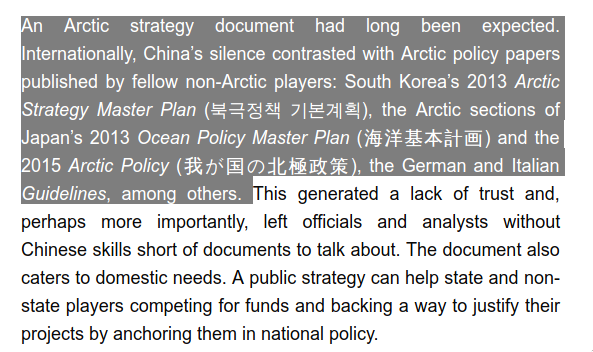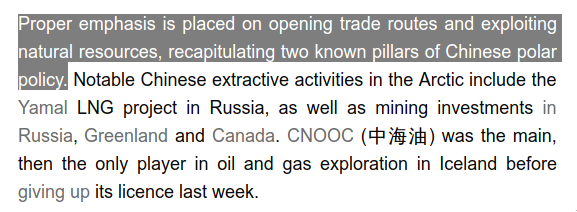An early April story by Kou Jie 寇杰 for the English-language People’s Daily website (“Breaking the ice: China’s entry in the Arctic region”) displays remarkable similarities with my early February piece for CPI Analysis (“The Arctic White Paper and China’s Arctic Strategy”). Viz.,
me, February:

An Arctic strategy document had long been expected. Internationally, China’s silence contrasted with Arctic policy papers published by fellow non-Arctic players: South Korea’s 2013 Arctic Strategy Master Plan (북극정책 기본계획), the Arctic sections of Japan’s 2013 Ocean Policy Master Plan (海洋基本計画) and the 2015 Arctic Policy (我が国の北極政策), the German and Italian Guidelines, among others.
Peep’s Deli, April:

The document had long been expected, as China’s non-Arctic players, including South Korea and Japan, established the Arctic Strategy Master Plan in 2013 and Arctic Policy in 2015 respectively.
—and again:
Lulu, Feb:

Proper emphasis is placed on opening trade routes and exploiting natural resources, recapitulating two known pillars of Chinese polar policy.
Peep’s, Apr:

In the document, China has emphasized its interests in opening trade routes and exploring natural resources as well as recapitulating two known pillars of its polar policy which are in line with the needs of many Arctic countries.
It will not escape the astute reader that the august Peep’s chose to steal the most innocuous bits of my piece, rather than its substance, which mostly deals with aspects of the PRC’s Arctic policy the January white paper doesn’t discuss. Another topic was the paper’s reception among those relying on exoprop materials, of which Kou’s less-than-fully-original article is itself a specimen.
The journalistic standards of exoprop media are well known, which makes ‘expert’ reliance on them even more telling. An interesting example of cheating readers and interviewees involves a China Daily op-ed attributed to a person who didn’t write it. But cheating higher-ups on the successes of propaganda efforts is also common. Memorious readers will remember this case at China Radio International I described in 2015 (“China’s state media and the outsourcing of soft power”, CPI Analysis):
In the 2009 article quoted above, CRI head Wang Gengnian bragged about how during the previous year the state broadcaster had “received more than 2.7 million letters and emails from listeners in 161 countries and regions.” At least for those countries and regions served through the Finland-based affiliate, that figure might not be entirely reliable: a Danish former employee wrote that, short of the reader reactions CRI demanded to see about their 2008 ‘Two Sessions’ coverage, the outfit’s staff simply penned a few themselves and submitted them to Beijing.
Indeed, the entire ‘borrowed boat’ / fake-foreign-reporter business is only successful as a charade meant to entertain the internal exoprop bureaucracy. Its actual propaganda value is negligible or negative, as these exercises often backfire. A recent example, the ‘eye-roll of the century’, was recently described in some length by Victor Mair in a guest post for this blog.
In another incident, China Daily online editor-in-chief Han Lei 韩蕾 reported last year in a piece posted on the website of the Cyberspace Administration of China (CAC, 国家互联网信息办公室) that the outlet had recruited nearly 200 foreign think-tankers to write “more than 300” op-eds “to influence more overseas audiences and explain China’s story well” (CAC, April 2017; partial translation by C.A. Yeung posted to a microblogging site). Such prowess had been achieved through “cooperation” with foreign think tanks, including the Sydney-based Lowy Institute. However, no evidence of such op-eds by Lowy-affiliated scholars could be found besides the fabricated piece referred to above, and a person from the institute, responding to Leung, called Han’s claims “[f]alse”.
Even more instructive is an incident involving higher-level authorities, the Confucius Institutes, a dubious ‘survey’ and the universally loved China Daily, resulting in multiple reports in English and Chinese repeating some remarkable linguistic claims. (The following paragraphs are an edited form of my earlier comments on Language Log, where the incident was discussed.)
A recent post by Victor Mair (“The language impact of the Confucius Institutes“) enigmatically proposed a list of pinyin words and phrases from a China Daily article. These had supposedly become known among foreigners, but the list included some Xiist Newspeak items that even people with some exposure to Chinese couldn’t recognise. As it emerged in the comments, the whole exercise was a manifestation of internal processes of the exoprop bureaucracy: a rather peculiar ‘survey‘ had been produced to prove the success of “people-to-people exchanges” mandated by Central Committee injunction (《关于加强和改进中外人文交流工作的若干意见》). The ‘survey’ was in turn used to produce positive-energy news stories that eventually reached the China Daily.
This involved writing, presumably with a straight face, that a Mandarin term sometimes translated as ‘Sincerity, Practical Results, Affinity and Good Faith’ (zhēn-shí-qīn-chéng 真实亲诚) enjoys 10.3% awareness in the Anglosphere, and is in fact better known among English speakers than the word for ‘dumpling’. To obtain such auspicious results, the “survey” was blended with online media searches. Another remarkable item: fèng 凤 ‘phoenix’ (36.7% awareness in India). What sort of “survey” can make toneless pinyin feng (as opposed to fenghuang (fènghuáng 凤凰)) recognisable as ‘phoenix’? Once you get 0 ‘awareness’ of feng=phoenix from a (hypothetical) survey with actual (hypothetical) people, how do you even design a biased online search to raise that to 36.7%, specifically in India? The Xi-speak item Mingyun gongtongti 命运共同体 (now officially translated as ‘community of shared future’; recently discussed by Nadège Rolland (“Beijing’s vision for a reshaped international order“)) has no less than 8.0% Anglosphere awareness. (A personal favourite, Ass Theory (驴论), didn’t make it to the survey, as it’s a Xiism only meant for domestic propaganda (endoprop).)

The theoretical framework for the report invoked no less an authority than peculiar ‘million-word’ business the Global Language Monitor (and its honcho Payack) to the effect that Chinese has been the main source of loanwords into English since 1994. The Monitor has been discussed on Language Log, and Payack had some interesting ‘exchanges’ with Zimmer, Pullum and Nunberg. There’s precedent for Payack being quoted in propaganda pieces (“Chinese puts in a good word for the English language“).
Quite likely, no one involved in the process believes these claims, but incentives are such that concocting the mock survey and attendant articles is easier and more fun than asserting this exoprop task has failed.
I look forward to reports to Relevant Honchi up the exoprop echelon on the Relevant Lulu ‘contributing’ to ‘telling China’s story well’ in the Arctic ‘new frontier’. Meanwhile, those following Arctic (or other) affairs are advised to take ‘analysis’ primarily relying on exoprop with a catty of salt.